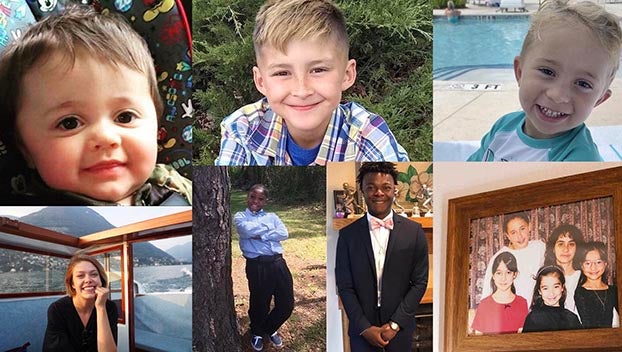The Forgotten Series: Children in Mississippi and throughout country become collateral damage in domestic violence epidemic
Published 1:31 pm Tuesday, August 30, 2022

- These children died at their father’s hand. Top row: Aaden Moreno, Ty Tesoriero, Greyson Kessler; bottom row: Claire Randall, Austin Edwards, Jordan Blackwell and three sisters, Rebecca, Katheryn and Leslie Gonzales. (Provided by MCIR)
By Jerry Mitchell
Mississippi Center For Investigative Reporting
Editor’s Note: This story is the first in the Forgotten series, which explores the often ignored victims of domestic violence homicides — not women alone, but children, other family members and even pets.
Tirany Savage told a Michigan judge in June that her estranged husband, Bo, was acting erratically and threatening violence.
“He keeps saying he is going to blow his brains out & I do not want my safety or my son’s safety in jeopardy,” the 35-year-old registered nurse told the judge in asking him to bar Bo from entering the family home.
Savage had reason to fear for the lives of herself and her son. “He has mental health issues (he quit taking his meds) & recently purchased a firearm,” wrote Savage, who filed for divorce after he had an affair.
The judge in Michigan’s 34th Circuit Court rejected her request for a restraining order, saying there was “insufficient evidence” and that she could ask later.
For Savage, there would be no later. In the days that followed, she made repeated 911 calls, telling dispatchers her husband was threatening her. Weeks later, he entered the Houghton Lake home with the gun he legally purchased, despite being a registered sex offender. Before taking his own life, he killed Savage, her 58-year-old mother and her 13-year-old son, Dayton, an animal-adoring teen who loved the outdoors.
Every year in America, children like Dayton become the collateral damage of murder-suicides whose real targets are their mothers. They are pawns in the ultimate act of revenge or control by abusive partners who sometimes take out their entire families — and other times leave the mothers alive to suffer unimaginable pain without their children.
The children are the most innocent of victims in the nation’s epidemic of domestic violence murder-suicides. And, often, they are the forgotten ones in the efforts to address the problem.
The nation has seen more than 1,300 murder-suicides in 2019 and 2020 alone, according to a database of such incidents compiled by the Mississippi Center for Investigative Reporting using online searches and information provided by the Violence Policy Center.
More than 1 in 7 of these murder-suicides involved the killings of children. More than 9 out of 10 of those children were killed by one of their parents, usually their father. And 9 out of 10 killers used a gun.
The database also revealed that every father who killed his children had been under a restraining or protective order or had previously carried out domestic violence.
MCIR created the database because a number of states, including Mississippi, fail to report such fatalities to the Centers for Disease Control and Prevention, which tracks all manners of deaths nationally. In 2019, the latest year data was available, the CDC showed 466 murder-suicides – far fewer than the 613 compiled by MCIR for that one year.
But the MCIR data is likely an undercount, too. Numerous studies suggest more than twice as many murder-suicides take place nationally each year. Some estimate it’s as high as 1,500.
There were at least 105 children killed in murder-suicides in 2019, according to MCIR’s database. That number rose to 131 children in 2020.
“If men can’t destroy women through homicide, they will destroy them through killing their kids,” nationally renowned advocate Kit Gruelle told MCIR. “It’s a unique form of annihilation.”
Despite the prevalence of murder-suicides and their strong link to domestic violence, little has been done nationally to assess the risk posed by controlling partners or to protect the women and children whom they’re most likely to kill.
Time and again, MCIR’s investigation shows, judges, police officers and even lawmakers have ignored red flags that precede these violent crimes, all but ensuring they continue to happen unabated.
Most of these murder-suicides in 2019 and 2020 took place in the South, led by Texas, California, Oklahoma and Florida.
Despite seeing at least 114 murder-suicides in just two years, Florida did not pass a proposed bill that would have stripped shared custody from fathers who threaten or commit domestic violence against the child’s mother.
The bill is named Greyson’s Law after 4-year-old Greyson Kessler, whose father, Stacey, killed him and then committed suicide in May 2021 during a custody battle with his mother, Alison.
Days before the incident, Stacey had threatened to cut off Alison’s head. After viewing the violent texts, a judge in Fort Lauderdale’s 17th Judicial Circuit Court approved a restraining order against Stacey but refused to remove the couple’s son from him.
Alison Kessler never saw her child alive again.
Evan Stark, author of “Coercive Control: How Men Entrap Women in Personal Life,” said for men bent on control “the child is dispensable. It’s a means to the end.”
Kessler told MCIR she will continue to fight for the bill’s passage. Until it becomes law, she doesn’t trust the system. For now, she advises mothers concerned about their children’s safety to “just take your kid and run because there’s nobody here to help you.”
So Why Do Men Kill Their Partners? Their Children?
Experts say motives behind these murder-suicides include financial woes, mental issues, and a toxic mix of jealousy, revenge and control.
April Zeoli, an associate professor of criminal justice at Michigan State University and expert in intimate partner violence, said some men kill because they feel their family can’t survive without them. Others suffer from mental issues.
She said the best area to focus on would be “intimate partner problems,” reported in nearly three-fourths of these murder-suicides.
In murder-suicides, the victim is often seeking to end the relationship, said David Adams, the author of “Why Do They Kill?: Men Who Murder Their Intimate Partners.”
The biggest myth surrounding domestic violence and murder-suicides is that they constitute irrational behavior, Adams said. “If you understand that the underlying reasons are power and control, it makes sense.”
Adams, co-founder of Emerge, the first counseling program in the nation for men who control and abuse women, said this kind of killer is typically “motivated by possessive control — the overarching term that includes jealousy, revenge and control.”
Kate Samson said she became a repeated victim of that control from her fiancé, Andrew Poppe, who would hold her down on the bed, choke her and threaten to kill her if she said anything.
When they first met, she believed Poppe was her dream man, coming into her life after her husband, Matt, died from lung cancer. The couple decided to have a child to add to her three children.
After the birth of their daughter, he became abusive. The worst came on April 18, 2019, when Poppe raped and strangled her. She managed to escape and reported what had happened to the police in Seymour, Wisconsin.
Officers knocked on Poppe’s door, but never got an answer. Eight hours later, they entered and found that Poppe had stabbed to death the couple’s 3-month-old baby, Hailey, as well as Samson’s 4-year-old daughter, Mattelin, before taking his own life.
Samson called the lack of intervention by police “insane … There was ample time to intervene. It’s sickening.”
Zeoli said the killings of many intimate partners involve custody disputes.
In 2011, Heidi DeLeon of Meridian, Idaho, divorced Edward Epps, but they fought over custody in the years that followed. Twice, she tried to get a restraining order but failed, despite the fact he held a gun to her head, according to Ada County court records.
In 2018, she called police again about his actions, saying he had posted threats against her and her children, but no charges were filed because police were unable to substantiate her claims, Zeoli said.
In January 2019, DeLeon finally won a restraining order against Epps after the judge examined an entry from her daughter’s diary in which Epps threatened to kill DeLeon and her children if he lost shared custody.
Eighteen hours after receiving that order, Epps stormed into their home with two handguns and killed DeLeon and her husband, Joe, before holding the two children hostage.
Only after police intervened did he finally release the children. Then he took his own life.
Some states require those served with restraining orders to relinquish their firearms. Idaho isn’t one of them. Neither is Mississippi.
Zeoli said studies put the use of guns in intimate partner murder-suicides between 61% and 89%. One study concluded that when men kill their female partners with guns, murder-suicide “was the norm.”
Adams said when a man kills his children and spares his partner, revenge is on his mind, “making her live the rest of her life without her children, and hopefully blaming herself for their deaths.”
Florida state Sen. Lori Berman — a Democrat who sponsored Greyson’s Law this year and plans to reintroduce the bill in 2023 — said typically “when a father kills a child, he is doing so out of revenge. There is often a history of domestic violence and-or coercive control, and this is a way for a father to ‘get back’ at the mother — by taking the thing that is most precious.”
Abusers kill when their control is ebbing, said Neil Websdale, director of the Family Violence Center at Northern Arizona University and author of “Familicidal Hearts: The Emotional Styles of 211 Killers.”
When a partner decides to break free by filing for separation or divorce, this is when men may resort to lethal violence. “The most dangerous time for women in an abusive relationship is when they decide to leave,” said Gruelle, who is also a domestic violence survivor. “And it’s the most dangerous time for children, too.”
In 2016, Jennifer Schlecht filed for a protection order against her abusive husband, Yonathan Tedla, according to family members. Each time, she tried to hand him divorce papers, he tore them up and refused to leave.
Three years later, she told her father she was determined to leave her husband now and that he had told her he “was going to ruin her or take them all down.”
Days later, Yonathan kept his word. On Nov. 6, 2019, he decapitated his wife and slit the throat of their 5-year-old daughter before hanging himself in their apartment in Harlem, New York.
These kinds of murder-suicides are sometimes called crimes of passion, but Zeoli said research suggests the opposite. She pointed to a 2014 study, which showed that in 83% of these homicide-suicides where partners and children were killed, there were signs of premeditation.
There were plenty of signs in the Colorado case involving Jing Tesoriero. Her ex-husband, Anthony, had been found guilty of domestic violence, convicted of a crime and had repeatedly violated the court’s protection order.
In 2019, a judge in a Denver suburb awarded her parenting time after Anthony had refused to let her see their 10-year-old son, Ty.
“Ty was a pawn, and he was using Ty,” Tesoriero told MCIR. “He kept violating probation on the criminal court side, but [the judge] didn’t hold him accountable.”
In a hearing, the judge made clear she was going to take primary custody away from him, but she allowed Ty to go home that night with his father — over Tesoriero’s objections.
“When I walked out, I was uncomfortable,” Tesoriero said. “I wanted to have Ty removed that day.”
At about 1 the next morning, she awoke to read a horrifying email from the father: “You might have thought you won something today but all you’ve done is lost everything for Ty….I was fully prepared today to kill … anyone … that got in my way. Luckily for them, the scumbag judge didn’t [issue] … any orders during the hearing. By the time you finish reading this, Ty will be moments away from joined [sic] me in the afterlife.”
She called 911 and sped to the father’s apartment, where she learned that he had shot her son in the head before committing suicide. “That was his ultimate way of hurting me,” she said. “He knew that taking Ty away from me would be the most traumatic thing he could do to me.”
Her lawyer, longtime family law attorney Caroline Cooley, told MCIR that the autopsy of Ty revealed there were bruises on his body from abuse by his father.
“In order to hurt the mother, they’re willing to hurt the child,” she said. “They’re unable to see the child as their own child and really just see the child as an extension of the mother.”
The protection order should have removed any guns the father had, she said, but that didn’t happen because no one enforced the order.
One problem is the same Colorado judges handling criminal cases are expected to rule on family law, she said. “We need to have a dedicated family court where the judicial officers receive training. It’s difficult for a judge to take these matters seriously when that judge has just finished sentencing someone in a murder trial.”
In the wake of Tesoriero’s case, a new Colorado law requires courts to hold a hearing within a dozen days to make sure the protection order is being enforced.
That might have saved Ty’s life, Cooley said. “If we don’t make sure the child is free from control and abuse, all we’re doing is institutionalizing continued abuse.”
Instead Of Making Arrest, Officer Went To Dinner
The U.S. Supreme Court has made it acceptable for law enforcement officers to ignore restraining orders, even when the law demands otherwise.
The reason? What happened to Jessica Lenahan.
She won a restraining order from a Colorado state trial court against her estranged husband, Simon Gonzales, but the judge modified his decision to require that the three daughters -– Leslie, Katheryn and Rebecca — who ranged in age from 7 to 10 visit their father on weekends, according to court records.
On June 22, 1999, a Tuesday between 5 and 5:30 p.m., they were playing in the front yard when the husband kidnapped the girls. Lenahan called the police in Castle Rock, Colorado, and showed them the restraining order.
Despite a Colorado law that required police to enforce violation of a restraining order with an arrest, they insisted there was nothing they could do, telling her to see if he showed back up with the girls by 10 p.m., according to court records.
At 8:30 p.m., the husband called and told her he had their three daughters at a Denver amusement park. But when she called the police, they repeated that she needed to wait until 10 p.m.
When her husband failed to show, she called again and was told to wait two more hours. At midnight, she called the dispatcher to let police know her daughters were still missing.
At 12:50 a.m., she completed an incident report for another officer, who “made no reasonable effort to enforce the [restraining order] or locate the three children. Instead, he went to dinner,” according to court records.
Three hours later, her husband showed up at the police station and opened fire with a semiautomatic handgun he had bought that evening. Police returned fire and killed him. Inside his pickup truck, police found the bodies of all three daughters he had killed.
Because the police failed to enforce the law, Lenahan filed a lawsuit. The 10th U.S. Circuit Court Court of Appeals ruled in her favor, but the U.S. Supreme Court in a majority opinion written by the late Justice Antonin Scalia reversed that decision, concluding that just because a law is mandatory doesn’t mean police have to enforce it.
Many legal experts have called the decision a dangerous precedent, saying it fails to ensure the protection of women under the Constitution.
The Harvard Undergraduate Law Review concluded that if Lenahan wasn’t entitled to have her restraining order enforced by law, “the restraining order itself holds no water.” This means, the Review said, “a system in which those affected by domestic violence truly have no state protections.”
Gruelle said law enforcement officials have told families that any lawsuit against them would fail because of this Supreme Court decision.
For Lenahan, the nightmares have never ended.
After her children’s killings, “my life stopped,” she told MCIR. “You can’t just be you anymore.”
Weeks ahead of each of her three daughters’ birthdays, her body begins to react, she said. “It will set me back six weeks.”
The date of their killings hits the hardest. On the 20th anniversary, she wept and began to experience problems with her legs, which forced her to retire.
These days, she pays as little attention as she can to the calendar. “That’s how I cope,” she said, “but my body knows.”
Taking A Look At Possible Solutions
For decades, domestic violence remained an afterthought for law enforcement and prosecutors, said longtime prosecutor Jaime Coulter. “We used to do little or nothing about domestic violence.”
In 1986, the International Association of Chiefs of Police started doing research on better methods of police response to domestic violence, and advocates’ push for change helped lead to the 1994 passage of the Violence Against Women Act, which urged a coordinated community response to domestic violence, sexual assault, stalking and other crimes.
In California, the 1994 murder of Nicole Brown Simpson led state legislators to enact some of the “most progressive domestic violence laws in the country,” said Coulter, who worked as a lead prosecutor in the Domestic Violence Unit in Orange County and now helps train law enforcement.
The tougher laws demanded the arrests of those believed to have carried out domestic violence and the seizure of weapons believed to have been used in the crimes.
Coulter said San Diego — along with other large American cities, such as New York City, Albuquerque and Minneapolis — started to look at domestic violence through a wider lens.
Authorities began prosecuting lesser domestic violence crimes and saw intimate partner homicides plummet. The Justice Department concluded that the more serious the sentence for domestic violence, the less the offenses are repeated.
If people are convicted of domestic violence, they aren’t allowed to possess or own guns under federal law, even in states like Mississippi, where the conviction is a misdemeanor.
Getting local officials to enforce this law takes education, said former U.S. Attorney Mike Hurst of Jackson. “In Mississippi, where we pride the 2nd Amendment so highly, there are some who don’t like it.”
But he said the evidence is clear: the presence of a gun in cases of intimate partner violence raises the risk of homicide by at least 500%.
After the pandemic began in 2020, gun homicides involving intimate partners rose 25% over the previous year, according to James Alan Fox, a professor and criminologist at Northeastern University.
To better understand Mississippi’s domestic violence problem, the attorney general’s office has started a new reporting system that will make it easier for officers to input data on domestic violence, said Michelle Williams, chief of staff for Mississippi Attorney General Lynn Fitch.
But such reporting is voluntary.
The office is also distributing a lethality risk test for officers to ask suspected victims of abuse to determine whether they are at high risk of becoming victims of violence.
“If the answers to a few questions are ‘yes,’ the officer needs to get the victim to assistance,” Williams said.
In 2010, Maryland became the first state to require law enforcement officers to use a lethality risk test to assess a victim’s risk for lethal violence.
In the five years that followed, the state saw a 34% drop in intimate partner homicides, according to a Virginia review of Lethality Assessment Programs across the U.S. Thirty-one states have since followed Maryland’s lead.
Mississippi isn’t one of them. Instead, the state attorney general’s office is supplying copies of the tool to law enforcement departments in hopes officers will utilize it, despite evidence of a growing need. Over the past year, Mississippi has seen an increase in protection orders from 4,305 to 5,211. In 2016, that number was 3,559.
After back-to-back murder-suicides in the summer of 2008, the High Point Police Department in North Carolina began examining the pattern of homicides in the city.
Paul Mustian, domestic violence coordinator for the High Point police, said the chief was horrified to learn a third of those killings involved intimate partners.
A deeper investigation showed that over a decade, more than 1,000 people had been charged with domestic violence. And these were far from one-time offenders. The average number of charges on each? Ten.
The chief reached out to criminologist David Kennedy, who developed the “focused deterrence” strategy to help combat gun and gang violence and was now suggesting the approach could help fight domestic violence.
The strategy involved hauling chronic offenders in and offering them help if they would change their behavior. If they refused, authorities promised to throw the book at them. Police say this strategy helped High Point cut its crime rate by nearly half.
Critics insisted this new approach to domestic violence wouldn’t work, because the crime was unpredictable, but the chief decided to partner with a dozen different groups, including prosecutors, probation and parole officers, child protective services, community groups, victims’ advocates and others, Mustian said. “That’s what helps the whole model work.”
To address those carrying out domestic violence, officials set up a four-tier system, starting with “D” and ending with “A.” The higher the grade, the worse the consequences.
In the years that followed, the city, which had been averaging up to five intimate partner homicides a year, saw its rate fall to zero for the first time.
In recent years, the numbers have begun to creep up again as overall homicides have increased, but the handful of those responsible for domestic violence homicides “were not on our radar,” Mustian said. “I do believe some of these were violent in other ways, but never had reports of intimate partner violence.
Although High Point has become a model for other cities around the world, Mustian knows of only 10 other cities in the U.S. that have sought to copy High Point’s system.
“A lot of people want to hop on board, but they don’t have the partnerships,” he said. Without those, the system can’t work, he said.
Because High Point’s model is proactive, it fails to appeal to some, said Gruelle, who trains law enforcement officers on how to best handle domestic violence cases. “Most communities wait until the s— hits the fan and say, ‘Oh, my God.’ It’s the same with school shootings.”
Fighting domestic violence takes a coordinated, community-wide effort involving police, other first responders, mental health professionals, schools, advocates and many others, she said. “Not all women are going to pick up the phone and call 911. That’s why everyone must be trained, because everyone is a potential first responder.”
Reforms must include a new mindset that values women and believes that domestic violence against them is a serious crime, she said. “If men were killed by female partners at the same rate that men kill women, the National Guard would be called out.”
MCIR Immersion Program students Lillian Hernández Caraballo and Melissa Perez-Carrillo created the murder-suicide database cited in this story. Immersion student Norma Hilton also worked on that database, which utilized six months of data from the Violence Policy Center. Both Hilton and Immersion student Katie Fogarty contributed to this report.
This story was produced in partnership with the Community Foundation for Mississippi’s local news collaborative, which is independently funded in part by Microsoft Corp. The collaborative includes Mississippi Today, MCIR, the Clarion Ledger, the Jackson Advocate, Jackson State University and Mississippi Public Broadcasting.
More News





